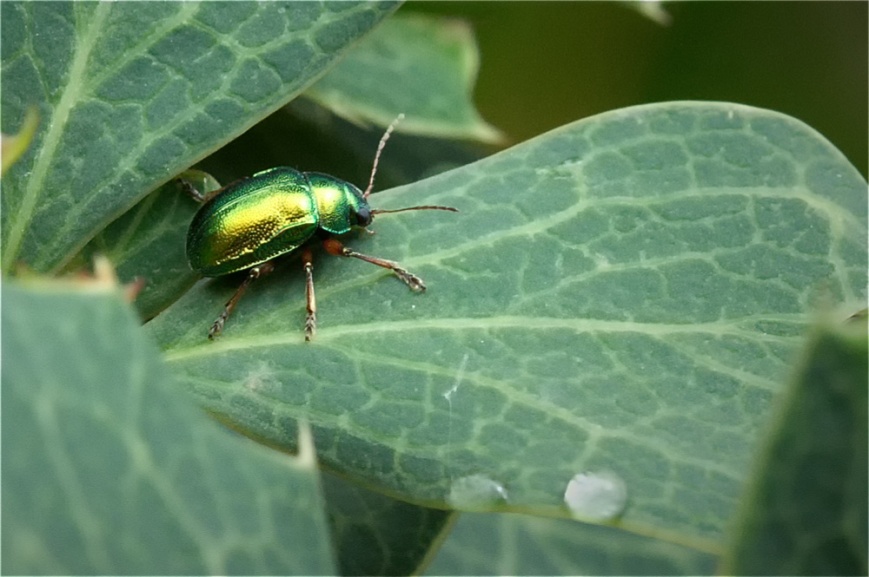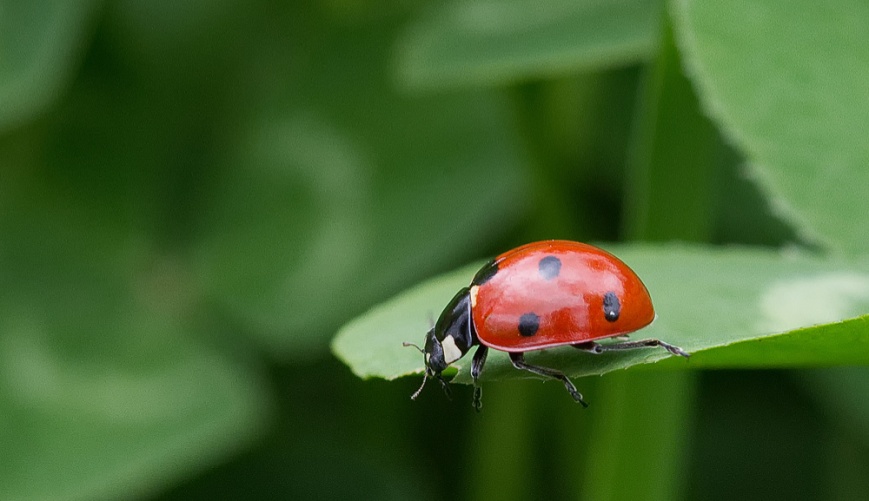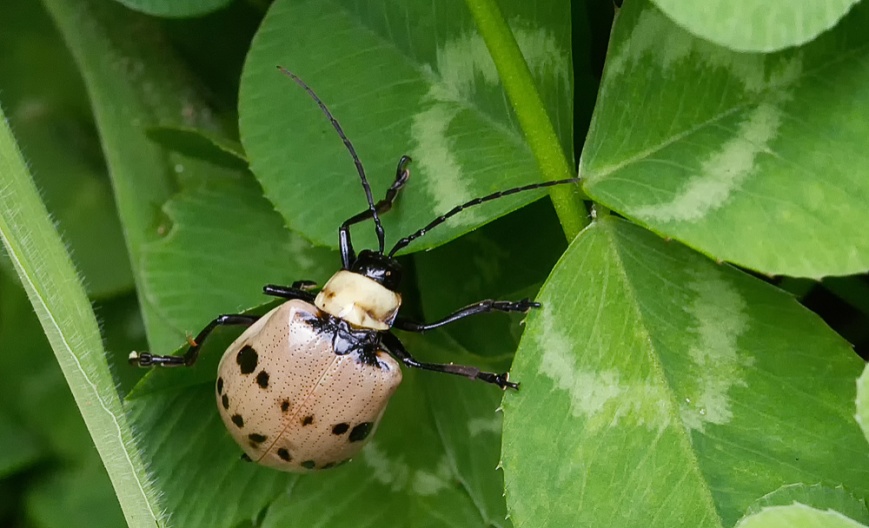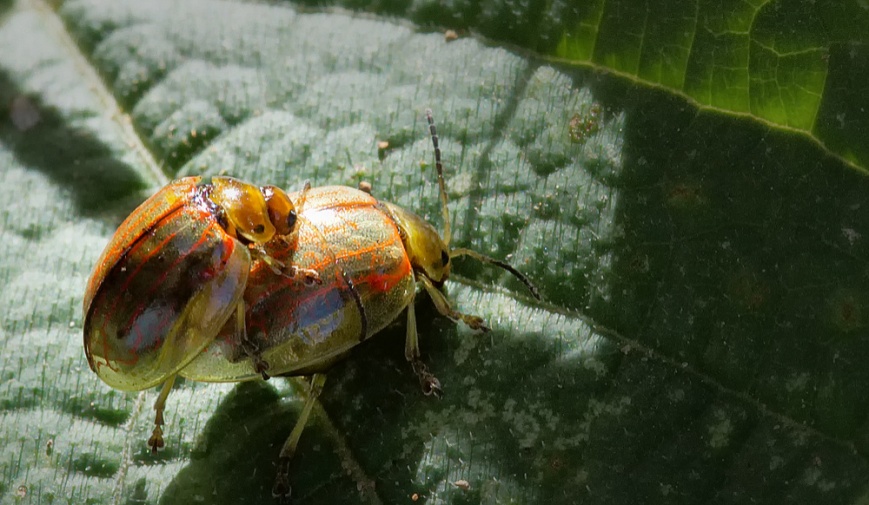Small insects have their own kind of world which very few are aware of. Photographing small insects is quite pleasing and full of some wonderful surprises. Though quite similar to macro photography and butterfly photography (links to these two articles are at the end), photographing small insects requires a different kind of skill set and a different way of photographing things.

(The tiny beetle here was comparable in size to the dew drops on the small leaves)
Insects are beautiful. The way they go about their lives is interesting. They undergo transformations during their lives, change colors, develop new abilities. Even simple activities like collecting food, mating, fighting each other, hiding from predators or simply basking in the sun after a bout of thunderstorm, can be very beautiful subjects for photography. One doesn’t even have to be an entomologist to enjoy these small peeks into the wonderful world of these tiny insects.

(A tiny ladybird on a clover leaf, trying to avoid a fall from the edge)
Challenges and Tips
The biggest challenge that comes forth while photographing small insects is their size itself. Unlike butterflies and moths, small insects are … well.. really really small. Even with a good macro lens, there will be need to extensively crop. Other option is to use extension tubes or any other macro aids along with a dedicated macro lens. I prefer to use a simple macro lens and then crop.
Since cropping is required eventually, noise becomes a problem. High ISO noise can mask the fine features of insects. Post-processing does not help much either. Reducing the noise, even with the most advanced of algorithms, leads to softening of the details. Trying to sharpen the image once again leads to increased noise! The solution – use as low an ISO as possible.
As is with macro, going so close requires a very small aperture to get reasonable depth of field. At least the insect should be completely visible. I prefer an aperture of around f/16 rather than f/22 or f/32, for most of my small insect photography. This gives me good depth of field without any softening that happens at extremely small apertures. For insects that do not appear to be in focus entirely – there are two options – 1. further lower down the aperture, 2. move a little away from the insect and later increase the amount of cropping during post-processing. I prefer the second option for the reason that I’ll state below.
Trying to keep the noise low by using low ISO and for reasonable depth of field using a small aperture, are two overpowering beasts in exposure settings. With these in place, to get a well exposed image, the shutter speed has to be reduced further. This is one of the reasons why I don’t prefer going to extremely small apertures. After all my aging hand is now not as stable as it used to be ten years back. Inadvert camera movement does creep in from time to time. So basically, it boils down to what is the lowest shutter speed you are able to use, hand-held. Work backwards from there and set a reasonable aperture and ISO.
Now the good news – these small insects in general are not aware of the existence of any serious threat from humans and so unlike butterflies, these do not fly away easily. (Sadly, humans are their biggest enemies, armed with all kinds of insecticides and an innate fear of anything crawling around). This gives us photographers an opportunity to go as close as we want to.
Shutter speeds should be kept as low as possible while avoiding camera shake. Insects move very slowly in general and so photographing them requires very stable hands. Tripods and monopods do not help since even a tiny bit of movement from insects and the settings need to be changed. I find them inconvenient to use with small insects. Give them a try if you want to. You might find them comfortable.
Use manual focus and then for fine-tuning move towards or away from the subject. Use Vibration Reduction or Optical Stabilization. This helps if your hands are unsteady and prone for lateral movement. (Interestingly, this technological innovation is useless in most of the macro work however for unsteady hands trying to photograph tiny insects, it does give a few extra usable stops)

(Beetle on clover leaves – this one was hiding under the leaves on a cloudy morning. As soon as the clouds cleared, the little fellow started moving towards the top of the clover leaves to enjoy a little bit of sunshine)
Become an expert at photographing these tiny wonders
These small insects are very sensitive to smells. Don’t use any kind of perfumes, deodorants or aftershaves if you want to go really close to them. Citronella oil and mosquito repellents are a big NO. In fact, don’t even use a scented soap for taking bath. If you are doused in a strong smell, you’ll still find insects but their numbers will be far less compared to what you could have seen without spreading any smell.
Have patience. These tiny insects are slow. They rest for long hours, sometimes on the leaves when it is cold and sometimes under the leaves, to hide away from predators and bright sun. Then they suddenly move, maybe to find a new resting place or maybe to feed. This when the beautiful photographs are created. Have patience. Don’t disturb them or make them move. Just wait and be ready with your camera.
Don’t use flash. Not even the ring flash meant for macro work. They show up in the reflections and spoil the beauty of the image. Not to mention, how irritating the bright flashes might be to these insects.
There’s no need to wear camouflage, but do wear dark clothes. Most of the insects have hard and reflective shells. Your clothes can reflect off their shells spoiling the photograph. Some time back I photographed a pair of tortoise beetles mating. I was wearing a white T-shirt then. The best photograph in the series got spoiled when my white T-shirt showed in the reflection on their shell. Thankfully, I noticed it after clicking a couple of photographs. For the remaining photographs, I sat bare-chest. Sure it was a sunny day and I ended up with a tan but then at least my remaining photographs did not get ruined.

(Beetles mating – their highly reflective shells were difficult to deal with.)
Nature is wonderful. Spare sometime admiring the insects too. Don’t just photograph them and move on. On the day when I photographed the ladybird which was about to fall off the leave, I spent around an hour near that patch of leaves, watching the ladybird. It balanced itself out on one leaf and just lay there for sometime. The legs were all hidden by its polka-dot wing-cover. After a few minutes, it felt the sun too strong. It moved on towards the lower side of the leaf. I watched it cover itself with the shade of the leaf.
Being ready with the camera helped. I did capture a few more shots while it rested under the leaf but that is not the point. What is important is to simply observe and be engrossed in their simple tiny world.

(Ladybird hiding under a leaf)
These small insects have their own way of life. Depending on the season (humidity, temperature) and time of the day, they may demonstrate some beautiful activities of theirs. In cold weather, insects will gather around the tops of the leaves to bask in sunlight. During harsh sunlight, they tend to hide under the leaves. During rains, small insects especially wasps create water bubbles in front of them. This is their method of reducing the humidity of their dwellings. Wasps, bees, ants and a few more related insects are quite social. The way they interact with their fellow beings can also be quite interesting for photographers. Dung beetles rolling up mud and dung balls, bees dancing (bee-scouts), spiders weaving their nets, or scorpionflies bribing their mates… these all can be scenes worth capturing for any photographer interested in insects.
Further reading:
Macro Photography
Photographing butterflies
White Clovers and Ladybirds (link to an external site, opens in a new tab)

Very well written articles with a View to teach and inspire the avid learner and tech savvy person . What I enjoyed was the easy conversational style to put the reader at ease immediately .
LikeLiked by 1 person
Beautiful photos!
LikeLike